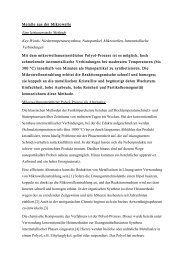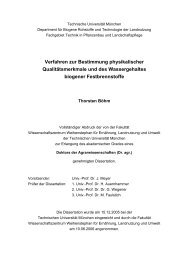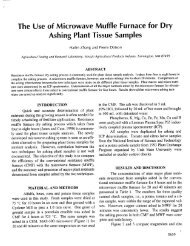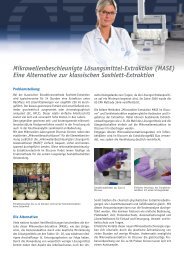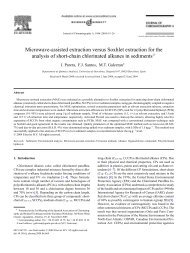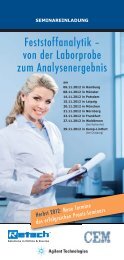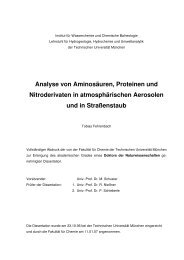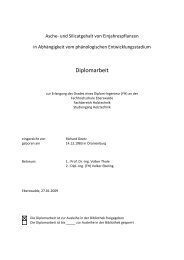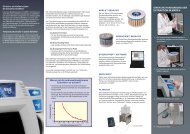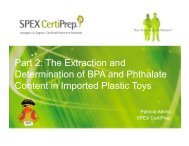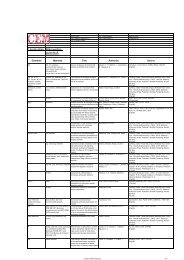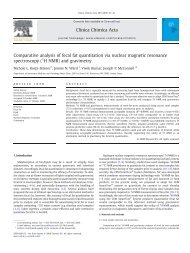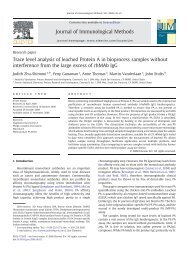Thermal Effects in the Organocatalytic Asymmetric Mannich Reaction
Thermal Effects in the Organocatalytic Asymmetric Mannich Reaction
Thermal Effects in the Organocatalytic Asymmetric Mannich Reaction
Create successful ePaper yourself
Turn your PDF publications into a flip-book with our unique Google optimized e-Paper software.
<strong>Thermal</strong> <strong>Effects</strong> <strong>in</strong> <strong>the</strong> <strong>Organocatalytic</strong><br />
<strong>Asymmetric</strong> <strong>Mannich</strong> <strong>Reaction</strong><br />
Belén Rodríguez and Carsten Bolm*<br />
Institute of Organic Chemistry, RWTH Aachen UniVersity,<br />
Landoltweg 1, D-52056 Aachen, Germany<br />
carsten.bolm@oc.rwth-aachen.de<br />
ReceiVed January 11, 2006<br />
The prol<strong>in</strong>e-catalyzed direct asymmetric <strong>Mannich</strong> reaction<br />
between cyclohexanone, formaldehyde, and various anil<strong>in</strong>es<br />
is <strong>the</strong>rmally accelerated. With only 0.5 mol % of catalyst,<br />
<strong>Mannich</strong> products with up to 98% ee have been obta<strong>in</strong>ed<br />
after a short period of time <strong>in</strong> reactions performed under<br />
microwave irradiation. In situ reduction of <strong>the</strong> result<strong>in</strong>g<br />
ketones affords N-aryl am<strong>in</strong>o alcohols <strong>in</strong> up to 86% yield.<br />
The <strong>Mannich</strong> reaction is one of <strong>the</strong> most useful carboncarbon<br />
bond-form<strong>in</strong>g reactions for <strong>the</strong> syn<strong>the</strong>sis of nitrogenconta<strong>in</strong><strong>in</strong>g<br />
molecules. Several catalytic versions have been<br />
developed, 1 and some of <strong>the</strong>m yield <strong>Mannich</strong>-type products with<br />
high enantioselectivities. Among all, <strong>the</strong> direct, one-pot, threecomponent<br />
<strong>Mannich</strong> reactions are <strong>the</strong> most elegant and syn<strong>the</strong>tically<br />
attractive. 2,3 Recently, List and co-workers 4 and Barbas<br />
and co-workers 5 <strong>in</strong>troduced a prol<strong>in</strong>e-catalyzed version (Scheme<br />
1), and enantioselectivities up to 99% ee have been achieved. 6<br />
* To whom <strong>the</strong> correspondence should be addressed. Fax: (Int.) +49 241<br />
809 2391. Phone: (Int.) +49 241 809 4675.<br />
(1) Reviews: (a) Arend, M.; Westermann, B.; Risch, N. Angew. Chem.,<br />
Int. Ed. 1998, 37, 1044. (b) Denmark, S. E.; Nicaise, O. J.-C. In<br />
ComprehensiVe <strong>Asymmetric</strong> Catalysis; Jacobsen, E. N., Pfaltz, A., Yamamoto,<br />
H., Eds.; Spr<strong>in</strong>ger: Berl<strong>in</strong>, 1999; Vol. 2, Chapter 26.2. (c) Marques,<br />
M. M. B. Angew. Chem., Int. Ed. 2006, 45, 348.<br />
(2) Review: Córdova, A. Acc. Chem. Res. 2004, 37, 102.<br />
(3) For a recent overview on multicomponent reactions, see: Ramón,<br />
D. J.; Yus, M. Angew. Chem., Int. Ed. 2005, 44, 1602.<br />
(4) (a) List, B. J. Am. Chem. Soc. 2000, 122, 9336. (b) List, B.; Pojarliev,<br />
P.; Biller, W. T.; Mart<strong>in</strong>, H. J. J. Am. Chem. Soc. 2002, 124, 827.<br />
(5) (a) Notz, W.; Sakthivel, K.; Bui, T.; Zhong, G.; Barbas, C. F., III.<br />
Tetrahedron Lett. 2001, 42, 199. (b) Córdova, A.; Notz, W.; Zhong, G.;<br />
Betancort, J. M.; Barbas, C. F., III. J. Am. Chem. Soc. 2002, 124, 1842. (c)<br />
Córdova, A.; Watanabe, S.-I.; Tanaka, F.; Notz, W.; Barbas, C. F., III. J.<br />
Am. Chem. Soc. 2002, 124, 1866. (d) Notz, W.; Watanabe, S.-I.; Chowdari,<br />
N. S.; Zhong, G.; Betancort, J. M.; Tanaka, F.; Barbas, C. F., III. AdV.<br />
Synth. Catal. 2004, 346, 1131. (e) See also: Mitsumori, S.; Zhang, H.;<br />
Cheong, P. H.-Y.; Houk, K. N.; Tanaka, F.; Barbas, C. F., III. J. Am. Chem.<br />
Soc. 2006, 128, 1040.<br />
(6) (a) <strong>Asymmetric</strong> Organocatalysis; Berkessel, A., Gröger, H., Eds.;<br />
Wiley-VCH: We<strong>in</strong>heim, Germany, 2005; Chapter 5.2. (b) For a recent<br />
application <strong>in</strong> syn<strong>the</strong>sis, see: Enders, D.; Grondal, C.; Vrettou, M.; Raabe,<br />
G. Angew. Chem., Int. Ed. 2005, 44, 4079.<br />
10.1021/jo060064d CCC: $33.50 © xxxx American Chemical Society<br />
Published on Web 02/15/2006<br />
SCHEME 1. One-Pot, Three-Component, <strong>Mannich</strong><br />
<strong>Reaction</strong> Catalyzed by (S)-Prol<strong>in</strong>e<br />
TABLE 1. Direct <strong>Asymmetric</strong> <strong>Mannich</strong> <strong>Reaction</strong> Catalyzed by<br />
(S)-Prol<strong>in</strong>e a<br />
entry 3 Ar<br />
mol%of<br />
catalyst<br />
time<br />
(h)<br />
yield b<br />
(%)<br />
ee c,d<br />
(%)<br />
1 a Ph 10 26 58 97<br />
2 b 4-CH3OC6H4 10 21 55 95<br />
3 c 4-(i-Pr)C6H4 10 24 40 98<br />
4 e a Ph 20 25 66 98<br />
5 f a Ph 20 30 81 98<br />
6 g a Ph 10 27 85 97<br />
a <strong>Reaction</strong> conditions: ketone 1a (2.6 equiv), aldehyde 2a (1.1 equiv),<br />
am<strong>in</strong>e 3 (1.0 equiv), and (S)-prol<strong>in</strong>e <strong>in</strong> DMSO (0.25 M with respect to 3)<br />
at 21 °C. b Yields of am<strong>in</strong>o alcohols 5. c Determ<strong>in</strong>ed by HPLC analysis of<br />
4 us<strong>in</strong>g a chiral column (Chiralcel AD); see Support<strong>in</strong>g Information for<br />
details. d The absolute configuration of 4 was found to be S, as determ<strong>in</strong>ed<br />
by a comparison with published HPLC retention times; comp. ref 7.<br />
e Performed at 25-30 °C. f Performed at 25-30 °C <strong>in</strong> DMF. g Performed<br />
at 45-50 °C.<br />
Whereas <strong>the</strong> enantioselectivities are impressive, two o<strong>the</strong>r<br />
important factors of this catalysis are more critical: first, <strong>the</strong><br />
catalyst load<strong>in</strong>g is generally high (g10 mol %), and second,<br />
<strong>the</strong> overall reaction time is long (5-48 h). Respective improvements<br />
would significantly <strong>in</strong>crease <strong>the</strong> syn<strong>the</strong>tic value of this<br />
important organocatalytic direct C-C bond-formation reaction<br />
and might eventually even have an impact on o<strong>the</strong>r transformations<br />
of this type.<br />
Recently, Córdova reported excellent results for <strong>the</strong> prol<strong>in</strong>ecatalyzed<br />
enantioselective R-am<strong>in</strong>omethylation of ketones. 7<br />
Typically, <strong>the</strong> reactions were performed us<strong>in</strong>g cyclohexanone<br />
(1a), formaldehyde (2a; 36% aqueous solution), and an aromatic<br />
am<strong>in</strong>e 3 <strong>in</strong> a solvent such as DMSO or DMF. A catalyst load<strong>in</strong>g<br />
of 10 mol % was reported to lead to excellent yields of<br />
R-arylam<strong>in</strong>omethylated ketones 4 with >99% ee after 16-24<br />
h at room temperature. With <strong>the</strong> goal to improve <strong>the</strong> abovementioned<br />
critical factors (catalyst load<strong>in</strong>g and reaction time)<br />
and to develop an optimized protocol, we began to <strong>in</strong>vestigate<br />
<strong>the</strong> <strong>in</strong>fluence of various reaction parameters on both yield and<br />
enantioselectivity <strong>in</strong> <strong>the</strong> formation of <strong>Mannich</strong> product 4a. 8 The<br />
results of <strong>the</strong>se studies are summarized <strong>in</strong> Table 1.<br />
In our experiments (with 10 mol % of (S)-prol<strong>in</strong>e <strong>in</strong> DMSO<br />
at 21 °C), <strong>the</strong> enantioselectivities <strong>in</strong> <strong>the</strong> conversions of anil<strong>in</strong>es<br />
3a-c ranged from 95 to 98% ee, and to our disappo<strong>in</strong>tment,<br />
<strong>the</strong> yields reached a maximum of only 58% (after reduction to<br />
(7) (a) Ibrahem, I.; Casas, J.; Córdova, A. Angew. Chem., Int. Ed. 2004,<br />
43, 6528. (b) Ibrahem, I.; Zou, W.; Casas, J.; Sundén, H.; Córdova, A.<br />
Tetrahedron 2006, 62, 357. (c) See also: Ibrahem, I.; Zou, W.; Engqvist,<br />
M.; Xu, Y.; Córdova, A. Chem.sEur. J. 2005, 11, 7024.<br />
PAGE EST: 3.4<br />
J. Org. Chem. XXXX, XX, A
TABLE 2. Microwave-Assisted Direct <strong>Asymmetric</strong> <strong>Mannich</strong> <strong>Reaction</strong> Catalyzed by (S)-Prol<strong>in</strong>e a<br />
entry 3 R<br />
mol%of<br />
catalyst<br />
am<strong>in</strong>o alcohol 5; Table 1, entries 1-3). Whereas longer reaction<br />
times did not affect <strong>the</strong> yield, better results were achieved by<br />
ei<strong>the</strong>r rais<strong>in</strong>g <strong>the</strong> temperature or <strong>in</strong>creas<strong>in</strong>g <strong>the</strong> catalyst amount.<br />
For example, <strong>the</strong> reaction with am<strong>in</strong>e 3a and 20 mol % of<br />
prol<strong>in</strong>e <strong>in</strong> DMF at 25-30 °C led to a product with 98% ee <strong>in</strong><br />
81% yield after 30 h (Table 1, entry 5). To our surprise, <strong>the</strong><br />
reaction mixture could even be heated to 40-50 °C (<strong>in</strong> a<br />
conventional oil bath), and under those conditions, with 10 mol<br />
% of <strong>the</strong> catalyst, <strong>the</strong> product was obta<strong>in</strong>ed <strong>in</strong> 85% yield, hav<strong>in</strong>g<br />
an ee of 98% (Table 1, entry 6).<br />
Still, <strong>the</strong> reaction required a high catalyst load<strong>in</strong>g and an<br />
extended reaction time. However, <strong>the</strong> observed high-temperature<br />
tolerance <strong>in</strong>dicated unexpected opportunities, lead<strong>in</strong>g us to<br />
consider explor<strong>in</strong>g <strong>the</strong> effect of microwave (MW) irradiation<br />
on <strong>the</strong> prol<strong>in</strong>e-catalyzed direct <strong>Mannich</strong> reaction. 9,10 To <strong>the</strong> best<br />
of our knowledge, <strong>the</strong>re is only a s<strong>in</strong>gle report on a MW-<strong>in</strong>duced<br />
accelerat<strong>in</strong>g effect <strong>in</strong> such asymmetric organocatalysis. In that<br />
study, Westermann showed that <strong>the</strong> <strong>Mannich</strong> reaction between<br />
2,2-dimethyl-1,3-dioxan-5-one and preformed p-methoxyphenylethyl-R-im<strong>in</strong>oethyl<br />
glyoxylate catalyzed by (S)-prol<strong>in</strong>e<br />
<strong>in</strong> TFE is accelerated under <strong>the</strong> action of MWs. 11-13 The best<br />
results were obta<strong>in</strong>ed us<strong>in</strong>g 30 mol % of <strong>the</strong> catalyst and 300<br />
W of maximal irradiated power. Under those conditions, <strong>the</strong><br />
product was obta<strong>in</strong>ed <strong>in</strong> 72% yield after only 10 m<strong>in</strong>. Interest<strong>in</strong>gly,<br />
<strong>in</strong> comparison to a reaction without a MW, performed at<br />
room temperature for 20 h, <strong>the</strong> stereoselectivity rema<strong>in</strong>ed almost<br />
<strong>the</strong> same (94% de and 99% ee versus 80% de and 95% ee with<br />
a MW). Fur<strong>the</strong>rmore, <strong>the</strong> authors observed that a decrease <strong>in</strong><br />
<strong>the</strong> irradiat<strong>in</strong>g power to 100 W led to a lower yield (64% yield)<br />
without affect<strong>in</strong>g <strong>the</strong> stereoselectivity. 14 Based on this result,<br />
and tak<strong>in</strong>g <strong>in</strong>to account our own observations on <strong>the</strong> temperature<br />
tolerance of <strong>the</strong> described <strong>Mannich</strong> reaction, we hypo<strong>the</strong>sized<br />
that MW irradiation could not only have a positive effect on<br />
<strong>the</strong> reaction rate but that it might also prove useful <strong>in</strong> lower<strong>in</strong>g<br />
<strong>the</strong> required catalyst load<strong>in</strong>g. Consequently, a study focus<strong>in</strong>g<br />
on this important issue was <strong>in</strong>itiated.<br />
power b<br />
(W)<br />
1 f a H 20 100 63 1 44 96<br />
2 f a H 20 15 42 2 79 98<br />
3 f a H 20 10 41 2.5 75 98<br />
4 a H 20 15 47 2 80 97<br />
5 a H 10 15 46 2.5 96 98<br />
6 a H 5 15 45 2.5 93 98<br />
7 a H 1 10 46 3.5 70 98<br />
8 a H 1 15 48 4 89 97<br />
9 a H 0.5 15 46 3 83 98<br />
10 b OCH3 10 15 47 2.5 71 95<br />
11 b OCH3 10 10 45 2.5 81 95<br />
12 b OCH3 1 10 47 3 84 94<br />
13 c i-Pr 10 10 45 3 71 97<br />
14 c i-Pr 5 15 51 3.5 88 97<br />
15 c i-Pr 1 15 47 4 83 97<br />
16 c i-Pr 0.5 15 49 4 86 97<br />
a <strong>Reaction</strong> conditions: same as those described <strong>in</strong> footnote a of Table 1, but under MW irradiation. b Application of constant MW power. c For cool<strong>in</strong>g,<br />
compressed air with a constant pressure of 0.7 bar (10 psi) was used dur<strong>in</strong>g <strong>the</strong> entire experiment. See also refs 16 and 17. d Yields of am<strong>in</strong>o alcohols 5.<br />
e Determ<strong>in</strong>ed by HPLC analysis of 4 us<strong>in</strong>g a chiral column (Chiralcel AD); see Support<strong>in</strong>g Information for details. f DMF was used as solvent.<br />
B J. Org. Chem.<br />
temp c<br />
(°C)<br />
time<br />
(h)<br />
yield d<br />
(%)<br />
ee e<br />
(%)<br />
First, we decided to search for <strong>the</strong> optimal conditions for a<br />
MW-assisted <strong>Mannich</strong> reaction. To ensure reproducibility and<br />
to standardize <strong>the</strong> reaction conditions, all experiments were<br />
performed <strong>in</strong> a Discover LabMate reactor from CEM Corporation.<br />
Fur<strong>the</strong>rmore, a constant MW irradiation power <strong>in</strong> conjunction<br />
with simultaneous air-cool<strong>in</strong>g (PowerMax option) was<br />
applied. 15-17 For <strong>the</strong> screen<strong>in</strong>g studies, anil<strong>in</strong>e (3a) was used<br />
as <strong>the</strong> am<strong>in</strong>e component <strong>in</strong> <strong>the</strong> coupl<strong>in</strong>g with cyclohexane (1a)<br />
and formaldehyde (2a). As shown <strong>in</strong> Table 2, <strong>the</strong> <strong>in</strong>itial<br />
(8) <strong>Mannich</strong> adducts 4 were found to be ra<strong>the</strong>r sensitive to racemization<br />
dur<strong>in</strong>g purification by column chromatography (even when alum<strong>in</strong>ium oxide<br />
was used as <strong>the</strong> stationary phase). For structural characterization (and after<br />
ee determ<strong>in</strong>ation), <strong>the</strong> crude products 4 were, <strong>the</strong>refore, immediately reduced<br />
with an excess of NaBH4, and <strong>the</strong> result<strong>in</strong>g am<strong>in</strong>o alcohols 5 (obta<strong>in</strong>ed as<br />
syn/anti mixtures, with <strong>the</strong> latter <strong>in</strong> excess) were <strong>the</strong>n analyzed. For details,<br />
see Support<strong>in</strong>g Information.<br />
(9) For recent reviews on <strong>the</strong> use of MWs <strong>in</strong> organic syn<strong>the</strong>sis, see: (a)<br />
Kappe, C. O. Angew. Chem., Int. Ed. 2004, 43, 6250. (b) Lidström, P.;<br />
Tierney, J.; Wa<strong>the</strong>y, B.; Westman, J. Tetrahedron 2001, 57, 9225. (c) Kappe,<br />
C. O.; Stadler, A. MicrowaVes <strong>in</strong> Organic and Medic<strong>in</strong>al Chemistry; Wiley-<br />
VCH: We<strong>in</strong>heim, Germany, 2005. (d) MicrowaVe Assisted Organic<br />
Syn<strong>the</strong>sis; Tierney, J. P., Lidström, P., Eds.; Blackwell: Oxford, U.K., 2005.<br />
(e) MicrowaVes <strong>in</strong> Organic Syn<strong>the</strong>sis; Loupy, A., Ed.; Wiley-VCH:<br />
We<strong>in</strong>heim, Germany, 2002. (f) Lee, J.; Hlasta, D. J. In Transition Metals<br />
for Organic Syn<strong>the</strong>sis, 2nd ed.; Beller, M., Bolm, C., Eds.; Wiley-VCH:<br />
We<strong>in</strong>heim, Germany, 2004; p 597.<br />
(10) For a study describ<strong>in</strong>g <strong>the</strong> effect of MW <strong>in</strong> (nonasymmetric)<br />
<strong>Mannich</strong>-type reactions catalyzed by CuCl <strong>in</strong> conjunction with an ionic<br />
liquid, see: Leadbeater, N. E.; Torenius, H. M.; Tye, H. Mol. DiVersity<br />
2003, 7, 135.<br />
(11) Westermann, B.; Neuhaus, C. Angew. Chem., Int. Ed. 2005, 44, 4077.<br />
(12) For an <strong>in</strong>terest<strong>in</strong>g study on MW-promoted reactions with supported<br />
enzymes <strong>in</strong> dry media, see: Carrillo-Muñoz, J.-R.; Bouvet, D.; Guibé-<br />
Jampel, E.; Loupy, A.; Petit, A. J. Org. Chem. 1996, 61, 7746.<br />
(13) For a review on MW-accelerated homogeneous (metal) catalysis,<br />
see: Larhed, M.; Moberg, C.; Hallberg, A. Acc. Chem. Res. 2002, 35, 717.<br />
(14) Unfortunately, <strong>in</strong>formation on <strong>the</strong> reaction temperature of <strong>the</strong><br />
experiments performed under MW irradiation is lack<strong>in</strong>g <strong>in</strong> this article.<br />
Fur<strong>the</strong>rmore, a comparison with conventional methods of heat<strong>in</strong>g has not<br />
been reported.<br />
(15) For a recent excellent study of MW-assisted reactions under<br />
simultaneous cool<strong>in</strong>g, see: Leadbeater, N. E.; Pillsbury, S. J.; Shanahan,<br />
E.; Williams, V. A. Tetrahedron 2005, 61, 3565.
TABLE 3. Direct <strong>Asymmetric</strong> <strong>Mannich</strong> <strong>Reaction</strong> between Ketone<br />
1a, Formaldehyde (2a), and Anil<strong>in</strong>e (3a) Catalyzed by (S)-Prol<strong>in</strong>e a<br />
entry<br />
mol%of<br />
catalyst<br />
temp<br />
(°C)<br />
time<br />
(h)<br />
yield b<br />
(%)<br />
ee c<br />
(%)<br />
1 1 45-50 23 82 97<br />
2 10 64-66 3 70 97<br />
3 10 64-66 4.5 79 96<br />
4 5 64-66 3 67 98<br />
5 5 64-66 4.5 82 98<br />
6 1 64-66 4 55 98<br />
7 1 64-66 8 68 98<br />
8 10 69-71 4.5 64 96<br />
9 5 69-71 4.5 69 98<br />
10 1 69-71 4.5 71 97<br />
11 10 75-77 6 72 95<br />
12 5 75-77 6 75 98<br />
13 1 75-77 6 84 98<br />
14 10 84-86 4.5 72 85<br />
15 10 90-93 4 68 78<br />
a <strong>Reaction</strong> conditions: same as those described <strong>in</strong> footnote a of Table<br />
1, but <strong>in</strong> a preheated oil bath with <strong>the</strong> given reaction temperature. b See<br />
footnote b of Table 1. c See footnote c of Table 1.<br />
conditions with DMF as solvent and us<strong>in</strong>g 100 W of MW power<br />
led to <strong>the</strong> correspond<strong>in</strong>g product <strong>in</strong> only poor yield (44% yield,<br />
Table 2, entry 1). However, positive effects on both yield and<br />
enantioselectivity were observed, when <strong>the</strong> MW power was<br />
reduced to 15 or 10 W (Table 2, entries 2 and 3). F<strong>in</strong>ally, <strong>the</strong><br />
use of DMSO as solvent led to consistently high yields and<br />
excellent enantioselectivities. For example, with 10 mol % of<br />
(S)-prol<strong>in</strong>e and a MW power of 15 W, <strong>the</strong> product was isolated<br />
(after only 2.5 h) <strong>in</strong> 96% yield, hav<strong>in</strong>g an ee of 98% (Table 2,<br />
entry 5). The most important observation concerned <strong>the</strong> catalyst<br />
load<strong>in</strong>g. Here, it was found that even with 0.5 mol % of (S)prol<strong>in</strong>e,<br />
83% of <strong>the</strong> product with 98% ee could be obta<strong>in</strong>ed<br />
(Table 2, entry 9)! Under <strong>the</strong> same MW conditions, substituted<br />
anil<strong>in</strong>es 3b and 3c reacted similarly and gave <strong>the</strong> correspond<strong>in</strong>g<br />
products <strong>in</strong> up to 84 and 88% yields, respectively (Table 2,<br />
entries 10-16). To our delight, no decrease <strong>in</strong> enantioselectivity<br />
was observed even with only 1 or 0.5 mol % of catalyst (Table<br />
2, entries 12 and 16).<br />
To fur<strong>the</strong>r evaluate <strong>the</strong> beneficial effect of MW irradiation<br />
and to <strong>the</strong> determ<strong>in</strong>e its real impact on <strong>the</strong> catalysis, we<br />
performed comparative studies us<strong>in</strong>g conventional oil bath<br />
heat<strong>in</strong>g. 18 In <strong>the</strong>se experiments, anil<strong>in</strong>e (3a) was used as <strong>the</strong><br />
am<strong>in</strong>e component <strong>in</strong> <strong>the</strong> coupl<strong>in</strong>g with cyclohexane (1a) and<br />
formaldehyde (2a). As a result of <strong>the</strong> potential <strong>in</strong>accuracy of<br />
<strong>the</strong> measurement by IR sensor, 16 a wide temperature range was<br />
scanned (Table 3). As expected, higher temperatures (also <strong>in</strong><br />
(16) In our setup, all temperatures were measured externally by an IR<br />
sensor. The temperature <strong>in</strong>dicated <strong>in</strong> Table 2 corresponds to <strong>the</strong> maximum<br />
temperature reached dur<strong>in</strong>g <strong>the</strong> experiment. Attempts to use a Discover<br />
CoolMate reactor from CEM Corporation equipped with an <strong>in</strong>ternal fiberoptic<br />
sensor device failed due to <strong>the</strong> temperature limitation (Tmax ) 40 °C)<br />
of <strong>the</strong> <strong>in</strong>strument. Thus, at <strong>the</strong> present stage, a reliable error marg<strong>in</strong> of <strong>the</strong><br />
given temperatures (Table 2) cannot be given. This should, however, not<br />
affect <strong>the</strong> reproducibility of <strong>the</strong> experiments. For a comparative study of<br />
temperature determ<strong>in</strong>ations under MW irradiations, see: Ondruschka, M.<br />
N. B.; Wei�, D.; Beckert, R.; Bonrath, W.; Gum, A. Chem. Eng. Technol.<br />
2005, 28, 871.<br />
(17) For comparison, <strong>the</strong> reaction between ketone 1a, formaldehyde (2a),<br />
and anil<strong>in</strong>e (3a), catalyzed by 10 mol % of (S)-prol<strong>in</strong>e, was performed us<strong>in</strong>g<br />
MW irradiation without simultaneous cool<strong>in</strong>g (15 W, 2.5 h; see also Table<br />
2, entry 5). Under <strong>the</strong>se conditions, <strong>the</strong> maximum temperature reached was<br />
89 °C, and <strong>the</strong> product was obta<strong>in</strong>ed <strong>in</strong> just 53% yield, hav<strong>in</strong>g an ee of<br />
91%. (The temperature profile is <strong>in</strong>cluded <strong>in</strong> Support<strong>in</strong>g Information).<br />
(18) <strong>Reaction</strong>s <strong>in</strong> oil bath were performed <strong>in</strong> <strong>the</strong> 10 mL glass vessels<br />
used <strong>in</strong> <strong>the</strong> MW-assisted experiments.<br />
comb<strong>in</strong>ation with <strong>in</strong>creased catalyst load<strong>in</strong>gs) resulted <strong>in</strong> faster<br />
reactions. Gratify<strong>in</strong>gly, also under those conditions, a reduction<br />
of <strong>the</strong> catalyst load<strong>in</strong>g was possible. For example, at 45-50<br />
°C, <strong>the</strong> use of 1 mol % of (S)-prol<strong>in</strong>e afforded 82% of <strong>the</strong><br />
product after 23 h (Table 3, entry 1), while at 75-77 °C, <strong>the</strong><br />
desired product was obta<strong>in</strong>ed <strong>in</strong> high yield (84%) after only 6<br />
h (Table 3, entry 13). In both reactions, <strong>the</strong> enantioselectivities<br />
were excellent (97-98% ee), confirm<strong>in</strong>g <strong>the</strong> previously observed<br />
high-temperature tolerance. Above a critical po<strong>in</strong>t,<br />
however, <strong>the</strong> enantioselectivities deceased significantly, and <strong>in</strong><br />
reactions performed at 84-86 °C and 90-93 °C with 10 mol<br />
% of catalyst, <strong>the</strong> products had only moderate enantiomeric<br />
excesses (Table 3, entries 14 and 15).<br />
The only ma<strong>in</strong> difference to <strong>the</strong> MW experiment was <strong>the</strong><br />
required reaction time, which under <strong>the</strong>rmal conditions had to<br />
be extended to achieve comparable conversion and yield.<br />
However, <strong>the</strong> observed rate enhancement could be a consequence<br />
of <strong>the</strong> fast heat<strong>in</strong>g of <strong>the</strong> reaction mixtures when<br />
irradiated <strong>in</strong> a MW field. For example, <strong>in</strong> those experiments,<br />
which were ran at 64-66 °C with 5 and 10 mol % of catalyst,<br />
<strong>the</strong> reaction was found to be almost complete after 4.5 h (see<br />
Table 3, entries 2-5). Thus, it has been proved that this direct<br />
asymmetric <strong>Mannich</strong> reaction catalyzed by (S)-prol<strong>in</strong>e is<br />
<strong>the</strong>rmally accelerated. It allows <strong>the</strong> reduction of <strong>the</strong> reaction<br />
times and, most importantly, <strong>the</strong> catalyst amount. Concretely,<br />
<strong>the</strong> use of constant MW irradiation at low power (10-15 W)<br />
<strong>in</strong> conjunction with simultaneous cool<strong>in</strong>g appears to access a<br />
reaction w<strong>in</strong>dow, which is well-balanced for achiev<strong>in</strong>g both a<br />
high reaction rate and an excellent enantioselectivity. 19 In this<br />
particular organocatalytic case, previously unseen low catalyst<br />
load<strong>in</strong>gs could be employed. Although no specific MW effect<br />
has been found, 20 <strong>the</strong> results are syn<strong>the</strong>tically promis<strong>in</strong>g and<br />
guided us to exam<strong>in</strong>e o<strong>the</strong>r organocatalytic asymmetric transformations<br />
on <strong>the</strong>ir sensitivity toward temperature.<br />
Experimental Section<br />
General Experimental Procedures. See <strong>the</strong> Support<strong>in</strong>g Information.<br />
General Procedure for <strong>the</strong> Prol<strong>in</strong>e-Catalyzed <strong>Asymmetric</strong><br />
<strong>Mannich</strong> <strong>Reaction</strong> under Microwave Irradiation. Preparation<br />
of (1R,2S)-2-Phenylam<strong>in</strong>omethyl-1-cyclohexanol (anti-5a) 21 as<br />
a Detailed Representative Example. In a 10 mL vessel was placed<br />
cyclohexanone (1a, 3.0 mL, 2.9 mmol, 2.6 equiv), formaldehyde<br />
(2a, 90µL, 36% aq solution, 1.2 mmol, 1.1 equiv), anil<strong>in</strong>e (3a,<br />
0.10 mL, 1.1 mmol, 1.0 equiv), (S)-prol<strong>in</strong>e (13 mg, 0.11 mmol, 10<br />
mol %), DMSO (4 mL), and a magnetic stir bar. The vessel was<br />
sealed with a septum, placed <strong>in</strong>to <strong>the</strong> MW cavity, and locked with<br />
<strong>the</strong> pressure device. Constant MW irradiation of 15 W as well as<br />
simultaneous air-cool<strong>in</strong>g (0.7 bar, 10 psi) were used dur<strong>in</strong>g <strong>the</strong> entire<br />
reaction time (2.5 h). After cool<strong>in</strong>g to room temperature, an aliquot<br />
of <strong>the</strong> crude reaction mixture (0.1 mL) was quenched with<br />
phosphate buffer pH 7.2, and was <strong>the</strong>n extracted with ethyl acetate<br />
(3 × 0.5 mL). The comb<strong>in</strong>ed organic phases were dried over<br />
MgSO4, and volatile organic materials were removed under reduced<br />
pressure. The ee was 97%, as determ<strong>in</strong>ed by HPLC analysis of <strong>the</strong><br />
crude <strong>Mannich</strong> product 4a7 (Daicel Chiralpak AD; heptane/<br />
2-propanol, 98:2, 0.5 mL/m<strong>in</strong>, λ ) 254 nm; major isomer, tS )<br />
(19) Analogous observations have also been made <strong>in</strong> o<strong>the</strong>r organocatalytic<br />
<strong>Mannich</strong>-type reactions. Kappe, C. O.; Barbieri, V. Personal communication.<br />
(20) For an excellent discussion on MW effects <strong>in</strong> organic syn<strong>the</strong>sis,<br />
see: Perreux, L.; Loupy, A. Tetrahedron 2001, 57, 9199.<br />
(21) (a) Masamune, T.; Takasugi, M.; Sug<strong>in</strong>ome, H.; Yokoyama, M. J.<br />
Org. Chem. 1964, 29, 681. (b) Modak, A. S.; Sahasrabudhe, S. D. Indian<br />
J. Chem., Sect. B 1984, 23, 980.<br />
J. Org. Chem. C
26.88 m<strong>in</strong>; m<strong>in</strong>or isomer, tR ) 32.33 m<strong>in</strong>). The rema<strong>in</strong><strong>in</strong>g crude<br />
reaction mixture was immediately reduced to <strong>the</strong> correspond<strong>in</strong>g<br />
alcohol by an excess of NaBH4 (100 mg, 2.6 mmol, 9.5 equiv).<br />
After stirr<strong>in</strong>g for 16 h, MeOH (5 mL) was added to <strong>the</strong> mixture,<br />
followed by a phosphate buffer solution (pH 7.2, 10 mL) and ethyl<br />
acetate (20 mL). The phases were separated, and <strong>the</strong> aqueous layer<br />
was extracted with ethyl acetate (3 × 15 mL). The comb<strong>in</strong>ed<br />
organic layers were dried over MgSO4. After removal of <strong>the</strong> solvent,<br />
<strong>the</strong> product was purified by column chromatography (silica gel,<br />
pentane/ethyl acetate, 9:1) to afford am<strong>in</strong>o alcohol 5a as a white<br />
solid (212 mg, 96% after two steps; syn/anti ) 1:5, determ<strong>in</strong>ed by<br />
1 H NMR). After recrystallization from pentane/Et2O (8:2), <strong>the</strong><br />
product (anti-5a) was obta<strong>in</strong>ed as white needles <strong>in</strong> almost diastereomerically<br />
pure form (syn/anti ) 1:40), mp 80-82 °C. 1 H NMR<br />
(400 MHz, CDCl3) δ 0.99-1.09 (m, 1H), 1.18-1.34 (m, 3H),<br />
1.49-1.63 (m, 1H), 1.67-1.82 (m, 3H), 1.95-2.00 (m, 1H), 3.11<br />
(dd, J ) 12.3, 4.3 Hz, 1H), 3.26 (dd, J ) 12.3, 8.2 Hz, 1H), 3.43-<br />
3.49 (m, 1H), 6.68-6.69 (m, 2H), 6.76 (tt, J ) 7.3, 1.1 Hz, 1H),<br />
7.17-7.22 (m, 2H). 13 C NMR (75 MHz, CDCl3) δ 24.5 (CH2),<br />
25.3 (CH2), 29.4 (CH2), 35.4 (CH2), 44.4 (CH), 50.4 (CH2), 76.1<br />
(CH), 113.9 (CH, 2C), 118.3 (CH), 129.2 (CH, 2C), 148.2 (C).<br />
Preparation of (1S,2S)-2-(4-Methoxyphenylam<strong>in</strong>omethyl)-1cyclohexanol<br />
(syn-5b) and (1R,2S)-2-(4-Methoxyphenylam<strong>in</strong>omethyl)-1-cyclohexanol<br />
(anti-5b). 7 Follow<strong>in</strong>g <strong>the</strong> general procedure<br />
us<strong>in</strong>g p-anisid<strong>in</strong>e (3b, 1.1 mmol scale) and a constant MW<br />
irradiation of 10 W dur<strong>in</strong>g 3 h afforded am<strong>in</strong>o alcohol 5b as white<br />
solid (213 mg, 84% after two steps; syn/anti ) 1:2, determ<strong>in</strong>ed by<br />
1 H NMR) after purification of <strong>the</strong> crude product by column<br />
chromatography (silica gel, pentane/ethyl acetate, 85:15). anti-5b<br />
(major): 1 H NMR (300 MHz, CDCl3) δ 0.93-1.07 (m, 1H), 1.19-<br />
1.36 (m, 3H), 1.41-1.82 (m, 4H), 1.93-1.99 (m, 1H), 3.02-3.25<br />
D J. Org. Chem. PAGE EST: 3.4<br />
(m, 2H), 3.41-3.49 (m, 1H), 3.75 (s, 3H), 6.66-6.70 (m, 2H),<br />
6.76-6.81 (m, 2H). syn-5b (m<strong>in</strong>or): 1 H NMR (300 MHz, CDCl3)<br />
δ 1.19-1.36 (m, 1H), 1.41-1.82 (m, 8H), 3.02-3.25 (m, 2H), 3.74<br />
(s, 3H), 4.02-4.05 (m, 1H), 6.60-6.63 (m, 2H), 6.76-6.81 (m,<br />
2H). anti-5b (major): 13 C NMR (75 MHz, CDCl3) δ 24.3 (CH2),<br />
25.3 (CH2), 29.3 (CH2), 35.1 (CH2), 44.2 (CH), 52.0 (CH2), 55.7<br />
(CH3), 76.4 (CH), 114.7 (CH, 2C), 115.7 (CH, 2C), 142.1 (C), 152.9<br />
(C). syn-5b (m<strong>in</strong>or): 13 C NMR (75 MHz, CDCl3) δ 20.6 (CH2),<br />
24.9 (CH3), 25.1 (CH), 32.9 (CH2), 40.5 (CH), 47.9 (CH2), 55.7<br />
(CH3), 68.7 (CH), 114.7 (CH, 2C), 114.8 (CH, 2C), 142.5 (C), 152.2<br />
(C). The ee was 94%, as determ<strong>in</strong>ed by HPLC analysis of <strong>the</strong> crude<br />
<strong>Mannich</strong> product 4b 7 (Daicel Chiralpak AD; heptane/2-propanol,<br />
96:4, 0.5 mL/m<strong>in</strong>, λ ) 254 nm; major isomer, tS ) 44.34 m<strong>in</strong>;<br />
m<strong>in</strong>or isomer, tR ) 61.28 m<strong>in</strong>).<br />
Acknowledgment. This work was supported by <strong>the</strong> Fonds<br />
der Chemischen Industrie and <strong>the</strong> Deutsche Forschungsgeme<strong>in</strong>schaft<br />
(DFG) with<strong>in</strong> <strong>the</strong> SPP 1179. We thank Prof. Dr. C. O.<br />
Kappe, University of Graz, for references, helpful discussions,<br />
and <strong>the</strong> opportunity for B.R. to visit his laboratories. Fur<strong>the</strong>rmore,<br />
we are grateful to CEM Corporation for be<strong>in</strong>g able to<br />
use <strong>the</strong>ir CoolMate reactor.<br />
Support<strong>in</strong>g Information Available: General experimental<br />
details, typical procedures, analytical data of products, 1 H and 13 C<br />
NMR spectra of compounds 5, and four examples of temperature,<br />
pressure, and power profiles for <strong>the</strong> MW-assisted reactions.<br />
This material is available free of charge via <strong>the</strong> Internet at<br />
http://pubs.acs.org.<br />
JO060064D



